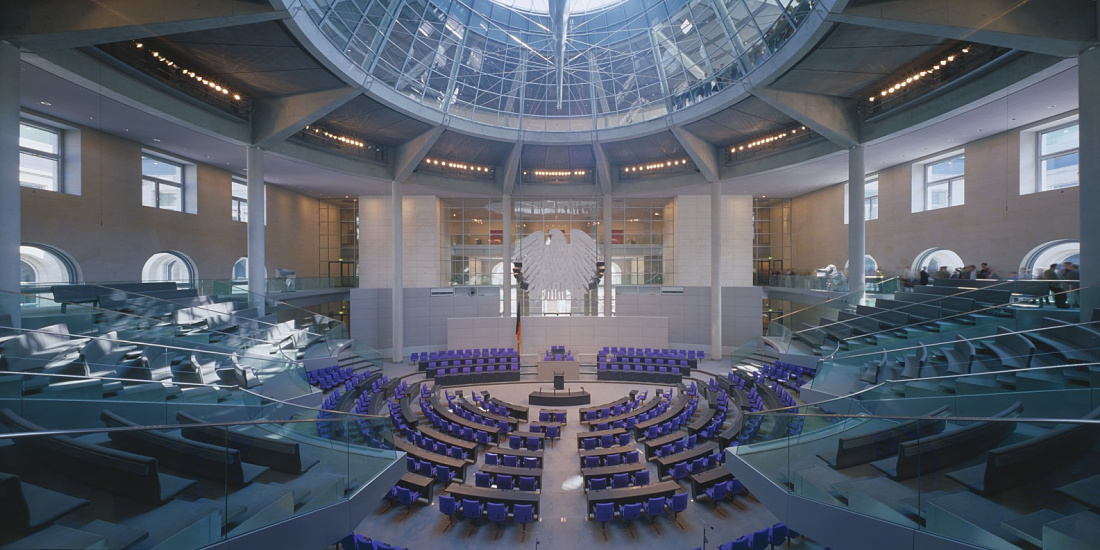


| Architect | Foster and Partners, London |
| Lighting designer | Claude Engle, Chevy Chase (CL) |
| Photographer | Rudi Meisel, Berlin; Anett Stuth, Berlin |
| Project location | Berlin |



At night, the illuminated dome of the Reichstag has been the new symbol of the German capital since 1999: The Reichstag, built between 1884 and 1894 following the plans of Paul Wallot, was renovated by Lord Norman Foster to become the seat of the German Bundestag (the lower house of the German Parliament). Since its reopening, a visit to the Reichstag and an ascent of the dome has been a firm part of the program of every Berlin tourist.
For ERCO as the main lighting supplier, the renovation of the Reichstag presented the challenge of developing a tailored lighting concept in close cooperation with architects, lighting designers, and specialist engineers.



The new Plenary Chamber under the glass dome constitutes the heart of the building. In his design, Foster followed the concept of adding the complex functions of modern parliamentary work as a contemporary layer to the carefully exposed historical substance. With his generous use of glass, he opened up new visual relationships, giving the building a previously non-existent quality of transparency and permeability.



The Reichstag is equipped with contemporary art, the acquisition of which was entrusted to a special parliamentary commission. Among others, those commissioned with it included Sigmar Polke (top), Markus Lüpertz (bottom left), Georg Baselitz (bottom centre), and Jenny Holzer (bottom right, talking to Lord Foster).


A special place among the artistic contributions in the Reichstag is occupied by the prayer and reflection room: It was designed and laid out in its entirety by Günther Uecker. Washlights for tungsten halogen lamps ensure an even illumination, with a wall aperture letting in a lateral glimmer of daylight.

The result: A soft and even illumination of the 'political arena', providing a high luminous quality for the media democracy without any hard shadows.


Thanks to their compact form, the light produced by low-voltage halogen lamps can be collimated very well, making them ideal for accent lighting.Further advantages offered by this light source - such as brilliant white light and excellent colour rendition - have meant that it has increasingly been used for ambient lighting over the past few years. ERCO constructed downlights and wallwashers for tungsten halogen lamps with 150W/24V for the first time ever for the Reichstag project. This meant that high-quality halogen light could be used to illuminate rooms of up to 4m in height and more.




Lighting the plenary chamber proves something of a balancing act, owing to a conflict of interests between the technical requirements for TV transmissions and the visual comfort needs of the members of parliament. Therefore, Claude Engle had a large number of spotlights installed on a circumferential gallery in order to reduce glare by distributing the required luminous flux. Each spotlight was individually focussed and fixed to avoid it being moved during later lamp replacement.

While the quality of the halogen light was the top priority in the more majestic areas of the building, the factors used to select the light sources for the stairway escape routes were completely different. The continuous operation of the luminaires meant that the lowest possible energy consumption was of great importance. At the same time, it was essential to guarantee that the luminaires would function perfectly in direct current operation in case of a power failure. Lightcast downlights for compact fluorescent lamps fitted with electronic control gear meet all of these requirements.

The Avalon light structures used on the ground floor solve complex lighting tasks: the lighting installation had to be integrated discreetly into the historic vaulted architecture and, at the same time, be capable of holding loudspeakers, emergency luminaires, escape route pictograms and sensors for daylight-dependent lighting control. In the Reichstag, one-lamp Avalon luminaires with 60% indirect and 40% direct light were used.












Deutscher Bundestag
Platz der Republik 1
11011 Berlin
Telephone: +49 30/227-0
Fax: +49 30/227-36 878 or 227-36 979
www.bundestag.de
E-Mail: mail@bundestag.de
Those involved:
Building sponsor: Federal Republic of Germany
Architects: Foster and Partners
(Sir Norman Foster, David Nelson, Mark Braun, Christian Hallmann, Ulrich Hamann, Dieter Müller, Ingo Pott)
www.fosterandpartners.com
Design of supporting structure: Leonhardt Andrä & Partner
Lighting planning: Amstein & Walthert / Karnasch Ingenieurges. mbH, Zurich/Berlin
Architectural lighting: Claude R. Engle, Chevy Chase/ Maryland
Technical lighting: Ingenieurbüro Holk & Kaletta, Berlin
Electrical installation: Elektro-Anlagenbau Wismar GmbH
Visiting information at:
www.bundestag.de/en/visittheBundestag
Further information on the building at:
www.bundestag.de/bau_kunst/index.html